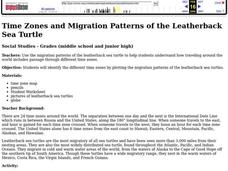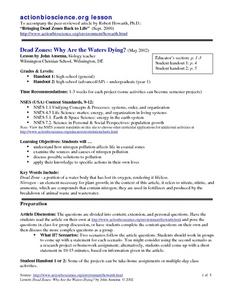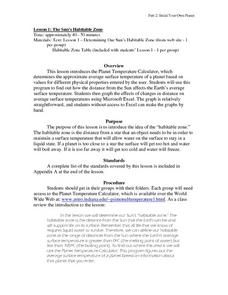Curated OER
Understanding Time Zones
Students investigate the times zones around the world. They discuss situations when it is important to know the time in different parts of the world and how to find it.
Curated OER
Time Zones and Migration Patterns of the Leatherback Sea Turtle
Students identify the different time zones by plotting the migration patterns of the leatherback sea turtles. They discover that traveling around the worlds includes passage through different time zones.
ProCon
Daylight Savings Time
An entomologist named Geroge Vernon Hudson is credited with proposing Daylight Saving Time (DST) so he could better study his insects. Using the informative website, scholars read a brief introduction to the topic and then explore the...
Curated OER
Costco and Zoning
High schoolers research zoning laws in their own communities through literature, Web and interviews, identify retailers attempting to build in your community, find out what kind of outlets have been built in nearby areas, explore ways...
Curated OER
Good Timing
Students investigate time, how people measure it, and how it influences our lives. They complete an online Webquest, analyze various calendars, answer discussion questions, and identify references to time in a newspaper article.
Curated OER
It's About Time: Olympics, Winter Sports, Math, Media, Time Zones
Students use the Internet to determine broadcast times for the Winter Olympic Games snowboarding competitions. In determining these times, they need to consider time zones throughout the world.
NOAA
Deep-Sea Ecosystems – Entering the Twilight Zone
Imagine an ecosystem without any light or oxygen, where living things convert carbon dioxide into food. This ecosystem is thriving and might just be the largest ecosystem on our planet, yet we know very little about it. The lesson...
Curated OER
Dead Zones: Why Are the Waters Dying?
Learners investigate the effects of pollution on marine ecosystems. They read and discuss an article, identify the effects of pollution on marine life, conduct research on local nutrient pollution, and conduct local water quality studies.
Curated OER
Time Zone
Eighth graders are given a year in history to research and identify the social and cultural situations at the time. In groups, they examine and describe various styles and periods of art and present them to the class. They relate the...
Curated OER
The West the Railroads made
Students investigate the effects of time and distance for the creation of a successful railroad. In this railroad activity, students recognize the railroad's need for an exact time schedule was the cause for the creation of time...
Curated OER
Zones of the Rocky Intertidal Zones
Sixth graders predict intertidal zones for organisms. In this intertidal zones lesson, 6th graders analyze an illustration of an organism and a class diagram of the intertidal zones. Students research to locate the zone the organism is...
NOAA
Tides
Low tides, high tides, spring tides, neap tides, diurnal tides, semidiurnal tides, mixed tides ... just how many types of tides are there? The 10th installment of a 23-part NOAA Enrichment in Marine sciences and Oceanography (NEMO)...
Curated OER
Time Zone
Eighth graders create an exhibition of images, ideas, developments and event from one year in history.
Curated OER
Entering The Twilight Zone
For this lesson sixth grade students get into groups and research a given ocean habitat. The major features of cold-seep communities are the objective but plenty information is given about other habitats which could be assigned to...
Curated OER
The Geophysics And Cultural Aspects of the Greater Antilles
Students determine location by using longitude and latitude. They measure to the minute longitude and latitude of a place and select a body of land and determine its location. They approximate time zones by using every 15 degrees of...
Curated OER
Traveling Through Literature
Integrate geography with literature in this interdisciplinary lesson. Begin by reading a poem such as The Time We Climbed Snake Mountain by Leslie Marmon Silko. On a large map, place push pins in the cities or states mentioned. An...
Curated OER
Guetemala's Changing Forest
Eighth graders compare their local ecological zone to the tropical rainforest. In this natural ecology instructional activity, 8th graders complete an activity about the differences in ecological zones. They compare their biome to the...
NOAA
I Can't Breathe!
The Gulf of Mexico dead zone, an area of low oxygen that kills marine life, costs the United States $82 million every year. Young scientists research anoxic ocean environments then come up with a hypothesis for the cause of the Gulf of...
Curated OER
Puberty/Adolescence, Day 2: "Who AM I? Where Am I Going?"
A great unit! There is a lot of content that is personal so make sure you have created a safe zone in your classroom before doing this lesson. It will have much more meaning if your learners share their life with others in the class....
Curated OER
Canada's Geographic Position
Ninth graders investigate the characteristics of the geographic position of Quebec and Canada in the World. They study Canada's land and water boundaries, surface area and time zones.
Curated OER
Specialized for the Sea
Students use pictures and make a mural to investigate how ocean animals are adapted to certain parts of their environment.
Curated OER
The Sun's habitable Zone
Students explore the average surface temperature of planets. They use the Planet Temperature Calculator to find the average temperature. Students explore how the distance from the sun affects the Earth's average surface temperature. They...
National First Ladies' Library
Who’s on First? in the End Zone? at the net? in the Ring?
Pupils are introduced to some sport heroes from the 20th century. They are told that although many sports have their own Halls of Fame, there is no one list of the top 10 athletes from the 20th century. It is their job to research famous...
Curated OER
Interstellar Real Estate - Defining The Habitable Zone
Students explore the orbital characteristics a planetary home needs to support Earth-like life forms. They develop an understanding of critical planetary mass to determine which newly discovered planets might be capable of supporting life.
Other popular searches
- Calculating Time Zones
- World Time Zones
- International Time Zones
- Lessons on Time Zones
- United States Time Zones
- Powerpoint and Time Zones
- Geography Time Zones
- Canadian Time Zones
- U.s. Time Zones
- Time Zones Lessons
- Time Zones and Asia
- Time Zones Manipulatives























